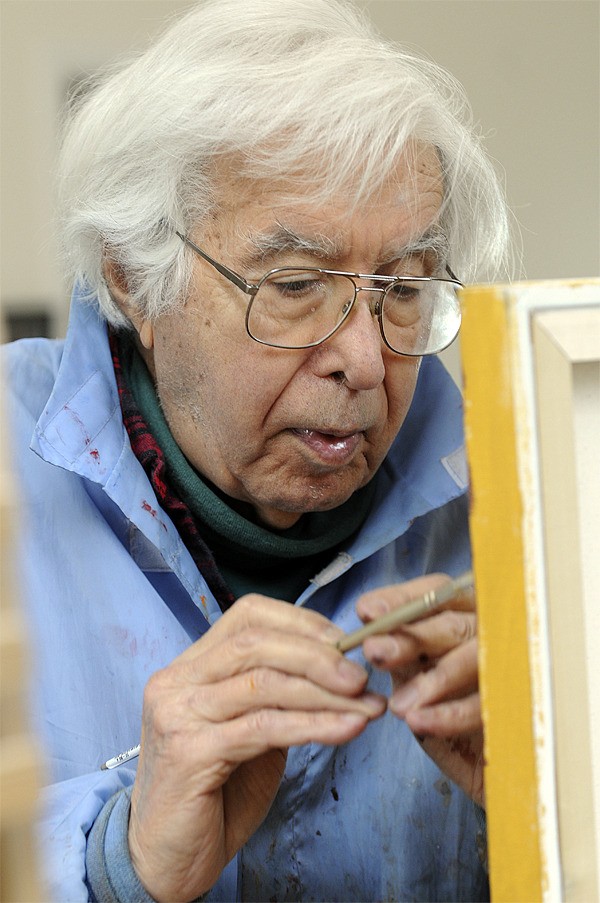Internationally renowned musician and painter Emanuel Vardi passed away Saturday, Jan. 29, at his home in North Bend, at the age of 95.
He enjoyed a long, varied, and much-distinguished career as a musician, winning acclaim with his skills in piano, violin and viola; and as a composer, producer, and painter. His passion for all of the arts maintained him even in his final days.
“He was painting up until two weeks ago,” said his wife Lenore, also a nationally recognized violinist and painter. “He was always thinking about art, and the next project.”
Locally the Vardis are known for their involvement with the 2010 Snoqualmie Valley Chamber Music Festival, and the Laurel Tree Gallery in Duvall which displays many of their works.
Emanuel Vardi was born in Jerusalem, and emigrated with his parents to New York in 1920. There, his birth date was officially recorded as April 21, 1915. However, Lenore noted that the date may actually have been Oct. 14, 1917, and that his parents claimed he was older so that he could be enrolled in school sooner.
His parents started his musical education even earlier. Emanuel started violin lessons from his father at age 2-1/2, and studied piano with his mother, debuting in concert at age 6 to critical acclaim. At 7, he started art classes.
“His father believed he should be versed in all the arts,” said Lenore.
Music was foremost in his life for decades, though. Lenore said he had “dazzling technique” whether on the violin or the viola, which he took up as a young man. Emanuel gave up the violin after hearing a recording from violist William Primrose, who later became his teacher.
“Then and there, he decided he was going to practice his violin repertoire on the viola,” Lenore said. The middle tones of the viola suited him better, anwyay, she felt. “He also had a sound on the viola that was unique, an unusual, gorgeous, lush sound.”
Emanuel was in his final year at the Juilliard School when he switched to the viola, long considered a secondary instrument. The school didn’t even have a viola department, and there were only two really accomplished violists performing in the ’30s, but Emanuel was determined to bring the viola into the spotlight.
“His whole philosophy was to prove the viola could do what the violin and cello could do,” Lenore said.
While at Juilliard, he gave a viola solo recital at New York’s Town Hall, which made an impression on conductor Arturo Toscanini, director of the elite NBC Symphony. He was offered a position with the symphony, which he quit school to accept in 1938. The symphony was in its second year then, and 21 year-old Emanuel, first violist, was its youngest member.
“He couldn’t even read the clef!” Lenore laughed. Violin parts are written in treble clef, but viola parts are written in alto clef. Emanuel had never learned since he generally just adapted violin music to the viola.
He performed weekly with the symphony and on his own solo radio show. When he was drafted in World War II, it was into the Navy Orchestra. He continued performing, and started teaching, composing, conducting—even writing jingles for a while with saxophonist Lenny Hambro—and producing records for such jazz greats as Louis Armstrong and Al Hirt. He performed all over the world, including, at First Lady Eleanor Roosevelt’s invitation, at the White House. He was one of only two violists ever to perform a solo recital at Carnegie Hall, and until recently, was the only violist ever to have recorded all 24 of Paganini’s Caprices for violin.
Emanuel also taught Lenore, a violinist who decided to try viola as a graduate student in 1977.
“He was a wonderful, wonderful teacher, very patient,” Lenore said. “He had a simple way of explaining things, and a simplicity of approach that was just beautiful… He taught me so much, and that was after I studied under all those other people.”
The couple performed together internationally, while Emanuel continued to follow his passion in music. Then a series of accidents in 1993 injured both his arms, and he was forced to give up performing.
“He could play, and he still sounded like Manny, but he didn’t have the virtuosity he was known for,” said Lenore.
After he gave up performing, the couple began to travel and explore other parts of the country, gradually moving west. Emanuel continued to teach and showed his art in galleries in Sedona, Ariz. and Dallas, Texas. The couple moved to North Bend three years. ago.
“He loved North Bend and absolutely loved Mount Si,” Lenore said. “He wanted to paint it, but he said ‘well, I think it’s been painted before.'”
Emanuel was diagnosed with prostate cancer in 1995, and had been treating it with an alternative-medicine approach. His health slowly declined until last year when the complications became more severe. He was under Hospice care until last Tuesday, Jan. 25, and he died at about 4 a.m. Saturday, Jan. 29.
Services are planned for North Bend and New York.



